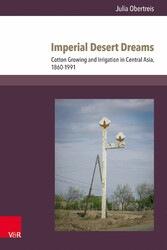Suche
Lesesoftware
Info / Kontakt
Imperial Desert Dreams - Cotton Growing and Irrigation in Central Asia, 1860-1991
von: Julia Obertreis
Vandenhoeck & Ruprecht Unipress, 2017
ISBN: 9783847007869 , 536 Seiten
Format: PDF
Kopierschutz: Wasserzeichen


Preis: 80,00 EUR
eBook anfordern 
Title Page
4
Copyright
5
Table of Contents
8
Body
12
Acknowledgements
12
Introduction
16
People, Geography, and Agriculture
26
Concepts, Approaches, and Questions
34
Sources, Languages, and Transliteration
48
I. Russian Colonial Rule in Turkestan, 1860–1917
50
The Motivation for the Conquest
52
The “Blossoming Oases”
57
A Cotton Fever
61
Local “Customs” and Local Knowledge
66
Engineers' Fantasies
77
The Ancient Riverbed of the Amu Darya
82
The Opening Up of the Hungry Steppe
86
The “Obituary List” of Failures and Moral Superiority
90
The Striving for “Cotton Autonomy”
97
The Legal Framework and Scepticism about “Capitalism”
104
The Ministry of Agriculture and the Turkestan Agricultural Society
116
The Taming of Nature through Infrastructure, 1910–1914
122
The First World War
131
Conclusion
133
II. Soviet Nation-Building and Stalinism, 1917–1944
140
The Advent of the Bolsheviks
141
Georgii K. Rizenkampf and his Cotton and Irrigation Program
148
“National Delimitation” and the “Land-Water Reform”
157
The Collectivization of Agriculture and the First Five-Year Plan
164
The Attack on “Bourgeois Specialists”
172
Haste, Coercion, and Incentives: Cotton Growing in the 1930s
179
Progressive Methods in Agriculture and the Experience of the Peasants
189
Terror
198
Stagnation in Irrigation Construction and Management
202
Scientific Institutes and the Training of (Indigenous) Specialists
207
“People's Construction”
214
The All-Union Agricultural Exhibition of 1939 and the Republics' National Designs
223
The Second World War
231
Conclusion
237
III. High Modernism in Central Asia, 1945–1969
246
Stalinism and Cotton Growing after the War
249
Agricultural Politics after Stalin
253
The Educational Boom and the Training of Indigenous Experts
265
The Hungry Steppe: a Microstudy
274
The New Zone
281
The Memoirs of the “Hungrysteppers”
287
Akop Sarkisov and the Recruitment of Cadres
290
Leadership Styles in the “Hungry Steppe Construction Trust”
302
Personal Networks: from Yangier to Tashkent to Moscow
305
Central Asians and the Druzhba narodov
315
“Teachers and Educators”
320
The “River of Happiness” – the Karakum Canal
322
The Drainage Problem
330
The Backwardness of the Others
335
“Engineerization”, “Chemicalization”, and “Mechanization”
340
Local Knowledge
357
“Irrational” Water Usage: the 1960s
360
Conclusion
367
IV. A Time of Crisis, 1970–1991
372
The Water Crisis
375
The Diversion of Siberian Rivers as a Solution to the Problem
383
The Cotton Crisis
388
The Individual Experience
391
Nature Protection and De-Stalinization
393
The Society for the Protection of Nature
398
An Ecocritique Emerges
401
The Cotton Scandal
411
Politics and Opposition during Perestroika
418
Debates in the Press and Environmental Scandals: Health
427
The Diversion Debate
429
The Vodniki under Fire
434
The Reaction of the Authorities
443
The Growth of Ethnic Conflict
447
Chemicals in Agriculture
448
Cotton and National Pride
451
A Feeling of Loss and Despair
455
Conclusion
458
Conclusion
464
High Modernism
464
Continuities between the Tsarist and Soviet Periods
471
Indigenization and the Cotton Contract
474
The Crisis of Soviet Modernity and Environmental Aspects
479
Central Asia Post-Soviet
483
Glossary
492
List of Maps and Illustrations
496
Bibliography
500
Index
528





